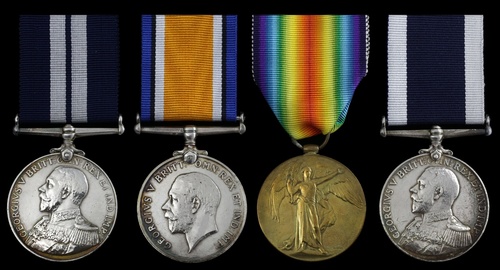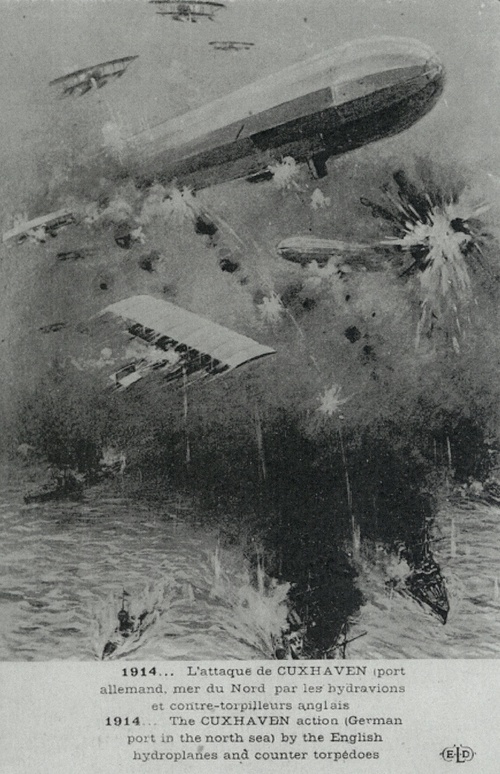Auction: 19001 - Orders, Decorations and Medals
Lot: 526
(x) A Great War D.S.M. group of three awarded to Chief Stoker H. C. Tibble, Royal Navy, a long-served submariner decorated for his part in J5 during Operation 'BB', the daring plan to 'flush out' enemy submarines near their bases, his sub had previously had the fortune to escape a 'blue-on-blue' torpedo from Captain Naismith, later of V.C. fame, during the Cuxhaven Raid on Christmas Day 1914
Distinguished Service Medal, G.V.R. (278813. H. C. Tibble, Sto. P.O. Submarine Service 1917.); British War Medal (278813 H. C. Tibble. Ch. Sto. R.N.); Naval L.S. & G.C., G.V.R. (278813. H. C. Tibble, Ch. Sto. H.M.S. Titania.), contact marks, very fine, sold together with a re-impressed V.M.
D.S.M. London Gazette 9 November 1917:
'For services in submarines in enemy waters.'
Henry Charles Tibble was born at Battersea, London in November 1875, the third son of Andrew and Frances Tibble. He enlisted in the Royal Navy on 22 January 1895 at Portsmouth and saw extensive service aboard a wide range of ships and shore bases, including the cruiser Tauranga which served in Australian waters. Returning home, he joined Drake on a tour of the Caribbean Islands in 1903, before returning to Portsmouth the next year and joining the submarine depot ship Thames on 16 March 1905. From here Tibble commenced an early career in the silent service, transferring to Mercury in 1906 and Vernon, the torpedo school ship at Porchester Creek, on 14 January 1913. On 24 August 1913 he joined Dolphin, the submarine depot and school at Fort Blockhouse, Gosport, before depot ship Adamant at Harwich for service in the Submarine D6 on 9 September 1913.
The Cuxhaven Raid: A narrow escape
As the Christmas Truce took place on parts of the Western Front, Tibble found himself in the thick of the action on Christmas Day 1914 during the Cuxhaven Raid, when combined British air and sea forces attepted to destroy the German Zeppelin base. As part of a line of 11 submarines places between the surface ships and the German coast, D6 had seen the British seaplanes return and land on the sea. Twice rising to the surface to see if she could help the crews, she firstly had a lucky escape when she was misidentified by Captain Martin Naismith (later Admiral V.C., K.C.B., K.C.M.G.) in the E11, who, mindful of orders to destroy British seaplanes that could not be brought home, focussed his attention upon machine gunning three empty seaplanes instead from the conning tower of his submarine. Rising for a second time, D6 found the German airship L-5 fifty feet directly overhead:
'With machine gun bullets clanging against his hull, he (Lt. Cdr. R. C. Halahan, Captain of D6) quickly submerged and headed for home.'
Tibble transferred to Maidstone and again Dolphin, before being appointed to the newly commissioned H7 on 1 July 1915, which had only been completed in Montreal a few days earlier. On 16 February 1916 he joined J5, which was commissioned in May 1916 under the command of C. P. Talbot.; it was a pretty inauspicious start. Sailing for a patrol off the Dogger Bank on 10 July, J5had great trouble with depth keeping and on one occasion hit the bottom at 140 feet. On 31 July, she was in collision with H.M.S. Vixen and had to be redocked at Blyth for repairs to the stem and bow shutters to No. 1 tube. Before the end of 1916, J5 was in dock on three further occasions and during the latter half of the year Commander E. C. Boyle, who had won the V.C. aboard E14 in the Sea of Marmora, assumed command.
Operation 'BB'
In June 1917, Admiral Beatty, flush with naval intelligence that predicted that a succession of U-boats would pass outward-bound through the North Sea between the 15th and 24th, decided to flood the area around the northern part of Scotalnd with four flotilla leaders, forty-nine destroyers and seventeen submaines, including J5. The surface ships were delployed in such as way as '...to force enemy submarines to dive through certain areas occupied by destroyers so (that) they would be on the surface whilst passing through adjacent areas occupied by our submarines.'
During the ten days allocated, 19 German submarines passed through this zone, 12 homeward bound and 7 outward bound; there were 26 sightings and 11 attacks made, eight by destroyers and three by submarines. For J5 and her crew, it had been a relatively quiet period but all that changed on 25 June when the British ships began to return to base and the Germans surfaced; J5 released four torpedoes from 6000 yards range at the conning tower of an enemy submarine. They missed and the Germans replied with the deck gun. On 9 July, through her periscope and in rough seas, J5 fired two torpedoes from 2000 yards at U-86; one hit the fore part of the submarine but failed to detonate. Between 28 July and 21 August 1917, J5 sighted enemy submarines on three further occasions.
Returning home, J5 was docked at Newcastle from 9 January to 26 March 1918. In the meantime, three members of the crew were duly honoured for their patrol; Tibble was awarded the D.S.M., Artificer Engineer William James Williams received the D.S.C., and Commander Cecil Ponsonby Talbot received a Bar to his D.S.O.
A near fatal error
Tibble remained with J5 for the rest of the war and had a lucky escape on 26 May 1918 when her Captain sighted a German submarine on the surface. Altering course, J5's speed was increased and her deck gun was manned. On closing to 8000 yards the target was identified as hostile and orders to fire were issued. However, after firing eight rounds, two of which may have been hits, the gun jammed and the J5 dived; she had been running however with the ventilators open, and in haste, these were not shut on diving. Surfacing again with a large bow-up angle and only 500 yards from the U-boat, the J5 was quite unmanageable. There was an estimated 40 tons of seawater in the engine room, chlorine was being given off from the batteries and a flare had been triggered. Luckily, in this moment of extreme vulnerability, the U-boat decided to make off after firing a few 'desultory and innaccurate' rounds, perhaps also damaged.
Following the conclusion of the Great War, the Admiralty presented the six remaining boats of the 'J' Class to the Australian Government. For Tibble, he could be glad of his transfer from D6, which had been sunk by U-73, in June 1918. He was demobilised on 20 January 1919, and eventually discharged from the Submarine Reserve on 10 April 1922; sold with extensive private research, including copied service record and correspondence between collectors and family members, noting his entitlement to a 1914-15 Star and eventual loss of this medal.
Reference sources:
Submarines at War, by Richard Compton-Hall.
Castles of Steel: Britain, Germany and the Winning of the Great War at Sea, by R. K. Massie.
Subject to 5% tax on Hammer Price in addition to 20% VAT on Buyer’s Premium. For more information please view Terms and Conditions for Buyers.
Sold for
£1,100









